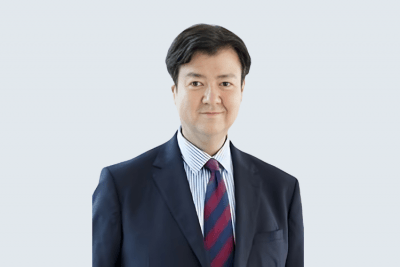Wealth Solutions & Wealth Planning
Delivering Effective, Relevant and Accessible Communication in Wealth Management

Mark Wightman of EY
Aug 19, 2021
Mark Wightman, Asia-Pacific Wealth & Asset Management Consulting Leader at EY, was one of our expert panellists at a Hubbis Digital Dialogue event on July 8 that focused on the art and science of communication in wealth management and the evolution of a more effective model for clients, advisors and providers alike. He believes wealth managers need to understand what their private clients consider as hygiene functionality and then truly focus on delivering differentiated communication and experiences. Data must be leveraged more efficiently to provide a more relevant, insightful and timely wealth management proposition to clients, who ultimately will, he believes, be willing to pay more for an elevated, integrated and an entirely better experience. Hubbis has summarised some of his valuable insights from that virtual event in this report.
A recognised thought leader in the region, Mark Wightman is the EY Asia-Pacific Wealth and Asset Management Consulting Leader and someone who thinks well ahead of the current models in place to the wealth management landscape of the future. Mark has led projects across the breadth of the wealth ecosystem with a focus on regional & global wealth transformation. He originally graduated BA and MA from Oxford University and has a deep knowledge of the Asian markets, having been a Singapore Permanent Resident for over 15 years and having focused on the Asia-Pacific market for over 25 years.
He joined EY in 2014 after spending over 20 years in the industry with operations, technology and strategy roles. Armed with this background and experience, Mark has somewhat of a privileged view of the evolution of the wealth management industry in Asia, including advances in digitisation, communication and the key priorities for the private banking sector.
The premise: be relevant and effective
From many interviews with Mark over the years and from his participation in a variety of our panels, we appreciate that his ‘big picture’ perspective is that, to compete effectively, private banks should leverage digital solutions to first understand their clients as deeply as possible, then from there curate the optimal flow of manageable and relevant information and ideas, and then communicate and deliver omnichannel experiences, but always in the preferred media of their individual clients.
Being relevant
“One word that strikes me in this discussion on communication in the wealth industry is ‘relevance’,” he told delegates on July 8.
“In short, there is too much information; people receive so much from every quarter and constantly. But to be of value, it has to be relevant, it has to be meaningful for the client, it must be timely, it must be easily understood, and it must be delivered effectively, and via the channels each client prefers.”
To be relevant, he said the bankers and advisors must first understand the clients, their personas, their individual journeys and so forth. And as to delivery, clients appear to like the hybrid relationship, in other words, part digital delivery and part personal/human delivery.
Knowing your clients, understanding your markets
“As to segmentation,” Mark commented, “many of the millennials, and particularly those in North Asia and China, have a greater propensity to go digital-first, so we have to be cognisant of how the particular clients think in terms of communication. But we need to allow clients the ability to converse with their bankers and wealth management firms in the ways that they prefer; some might be highly digital, some might like the more traditional and human-led approach.”
The thrust towards conversational banking
He also explained that amongst many clients EY works for in the wealth management field, there had been an accelerating drive towards what is known as ‘conversational banking’. “There’s been a lot more focus amongst clients on being able to provide secure, compliant communication through WhatsApp, WeChat and so forth,” he explained. “There are also levels to those conversations. Initially, it is simply having secure conversations with RMs and advisors. Secondly, can information and details be exchanged securely? And thirdly, can the clients then transact safely and simply? So, with the remote work practices nowadays, we are seeing this drive to conversational banking that leads to simplified transactional banking.”
Data must be relevant and handled wisely
Mark then zoomed in on data and the challenges around exchanging data efficiently and securely with clients. “Many private clients are actually multi-jurisdictional,” he commented, “perhaps with homes in Singapore, the UK, Hong Kong and so forth. We then have to think about regulations around data and privacy, and marry the clients’ desire for holistic servicing with an optimal compliant service model. We have to think also about what data clients are comfortable sharing and how this should be delivered and received.”
He also focused in on ESG, which he quipped nowadays seems to appear in some form or another in virtually every wealth management discussion. He referred to a survey EY had conducted that showed how important sustainability is to clients in the region these days, but that also highlighted how wealth providers are not necessarily doing a very good job of delivering on those goals. “That is one example of where data and information from the providers are lacking, where they are not fulfilling the needs for those particular client goals.”
Keep a close eye on costs
Mark also tackled the thorny issue of how wealth managers actually go about their digitisation. “People are doubling down on Asia because they see this is where the growth will be,” he commented. “But at the same time, they have to look at costs, and that is certainly the case for the digitisation journey. In theory, at least, greater automation should de-risk the businesses and drive those efficiencies, but it is very important to always look at this thrust through the lens of the cost and the value that can be extracted for all parties involved.”
Three core elements on the compass
Mark observed that there are three key elements to the development of effective solutions – the needs and expectations of the clients, the needs of the business and RMs to help deliver efficiently and effectively on those clients ‘wants’, and a robust perspective on what is happening amongst competitors in the wealth industry. “Clearly, if we are working with the ‘C’ suite decision-makers, they need to really understand these three key elements in order to formulate strategy,” he stated.
The shortage of talent
Narrowing his focus on the RMs, he commented that, right now, there is a remarkable and very public race to hire more and more RMs in Asia, with huge numbers being cited in a seemingly constant flow of press releases from the banks.
“But the reality is there are simply not enough experienced and good quality RMs around today,” he said. “There are not enough trained RMs to meet demand, and people in priority banking roles can’t simply be resprayed and overnight become private bankers to the HNWIs and ultra-wealthy clients,” he cautioned.
Smart technology can really help
Accordingly, he said that technology has to be leveraged to cover what are essential ‘hygiene’ elements these days, the transactional interactions with the clients, for example. “And we must focus the RMs more on the value-added they can deliver, whether that's true portfolio-based advisory, whether it's going deeper into alternatives, private deals, or with other more elevated offerings,” he advised. “However, as I said, the wealth industry must be constantly vigilant over costs and must determine very carefully where they can bring the RMs and ICs in for the more ‘white glove’ model.”
Consistency is essential across the wealth spectrum
And Mark advised delegates that there needs to be greater consistency in how the banks approach clients across the different segments of wealth. He said that often when clients move within the wealth continuum, especially from mass affluent to HNW status, they often effectively have to onboard again; it is almost like opening an account with another bank entirely and their digital capabilities may actually move backwards!
He counselled that the banks must therefore aim to make all that considerably simpler, and remarked that while there is so much excitement in Asia and so much hiring taking place, banks must take a long, hard look at the model they want to roll out, the service model they want to offer and how they will effectively boost the skills and productivity of their advisors and RMs.
Democratising the world of investments
Mark observed that another trend is the democratisation of investment opportunities across lower categories of wealth. For example, banks are looking at how they can offer their mass affluent customers alternative assets that hitherto have been targeted only at the HNW and above segments. He said education around financial literacy, more technology, greater digitisation, and greater agility will all be drivers to help these banks offer a better range of products and ideas across the various categories of wealth in the region.
And he said that although the term hyper-personalisation is perhaps very overused these days, the banks must do better at assembling data on their customers, including ultimately how they want to be communicated with, in order to deliver the relevant, insightful, value-added timely and valuable information, ideas and advice. “Real personalisation is certainly a key trend for the future and one that many of our clients are working hard to achieve,” he said.
Delivery with consistency and integrity
And then, throughout each organisation, Mark observed they need to build and demonstrate a real consistency of experience and services as customers move through the wealth continuum.
Clearly, the wealthier the clients become, the more sophisticated the services, products and advice they will be offered. And as advice becomes more important to the clients, as a broader portfolio approach is taken to their investments, it is vital that goals and objectives and risks are aligned properly with tailored, relevant ideas and recommendations. Technology, he commented, can help wealth management organisations achieve those aims as long as the right approaches and the right strategies are put in place at the outset.
Alignment of the business model
Mark even noted that the right compensation models for team members must be put in place as part of the overall strategy, as there needs to be a real alignment of the customer's interests and the RM’s business objectives. The rise of DPM in Asia, he indicated, had, for example, been gradually reducing the product ‘push-type’ approach that dominated the private banking landscape historically.
“So,” he concluded, “it is all about the alignment of the commercial models and strategic business goals, and in doing so, of course, technology can certainly help, but it is not an end in itself; technology is an enabler that helps the wealth industry achieve these goals in a more holistic and engaging manner.”

Asia-Pacific Wealth & Asset Management Consulting Leader at EY

More from Mark Wightman, EY
Latest Articles






